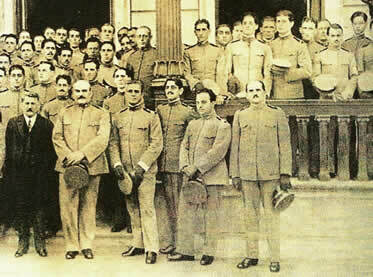When we study the motivations for the outbreak of the First World War (1914 – 1918), books usually to point out the political feuds and nationalist tendencies that installed a climate of tension and hatred between nations European countries. However, the generalizing tone of the narrative contained in these texts fails to embrace many peculiar situations that occurred during this conflict. To exemplify this point, let's talk a little about the first conflicts of the war, which took place between 1914 and 1915.
In this phase, enemy nations were entrenched in huge ditches filled with weapons and soldiers. However, prepared for a conflict since the end of the 19th century, the countries involved in that great war could not obtain an advantage against enemies that had an equivalent power of destruction. In addition, several reports tell of a series of practices and behaviors that escaped that “romantic ideal” of uninterrupted struggle against hateful foreign troops.
In fact, the environment in the trenches provided a great approximation between the soles involved in the conflict. According to some writings by those in combat, soldiers in a trench could hear the conversations, laughter and chants of an enemy trench located a few meters away. In fact, entering a war where many did not understand or believe in their motivations ended up creating situations of communion between rivals.
In December 1914, there was several truce between enemy troops, British, French and German soldiers met to celebrate Christmas. This type of situation, in addition to demonstrating the inconsistency of nationalist ideas, also symbolized the frustration of a war where both sides believed in a quick victory. In certain regions, enemies even exchanged gifts and set up small makeshift Christmas trees.
The surprising attitude taken by the combatants ended up inciting greater inspection by the highest levels, who began to avoid any kind of truce not authorized by the commanders. However, to avoid problems with superior commanders, many soldiers reported in their diaries the approach of enemies, trying to evade any blame for the established truce. However, other low-ranking soldiers' diaries mentioned “good neighbors” or performing the so-called “live and let live”.
In this way, we can see in this type of situation a rich source of understanding of the past where we see the mismatch between the official report and the narrative of individuals who lived a certain History. It would be strange, at the very least, to think that hatred and killing dominated all those fifty months that marked the First War. Being made by the action of men, History experiences paths that often escape our gaze.
By Rainer Sousa
Graduated in History
Do not stop now... There's more after the advertising ;)
Would you like to reference this text in a school or academic work? Look:
SOUSA, Rainer Gonçalves. "Christmas of the Enemies"; Brazil School. Available in: https://brasilescola.uol.com.br/guerras/natal-dos-inimigos.htm. Accessed on June 28, 2021.

